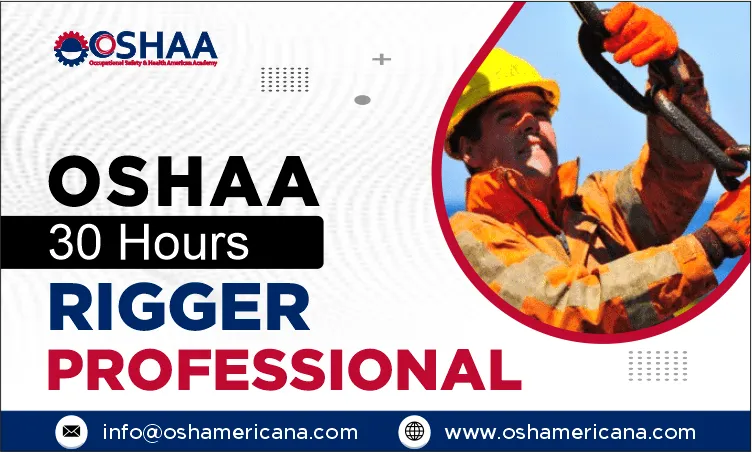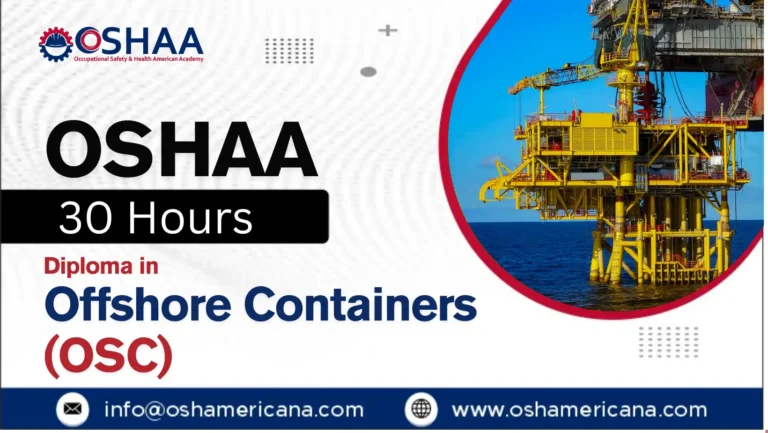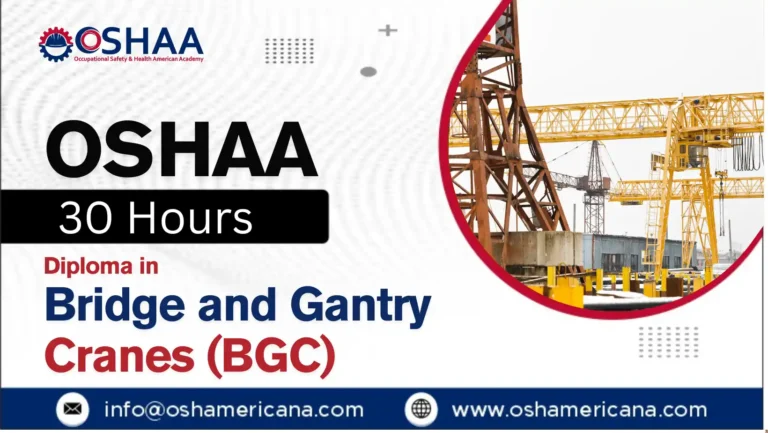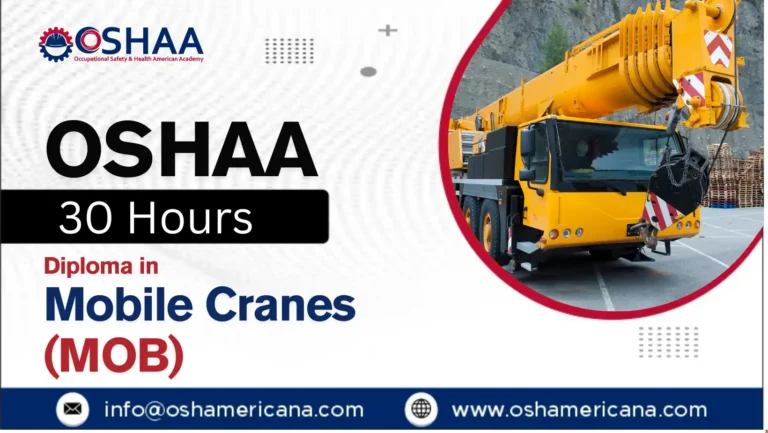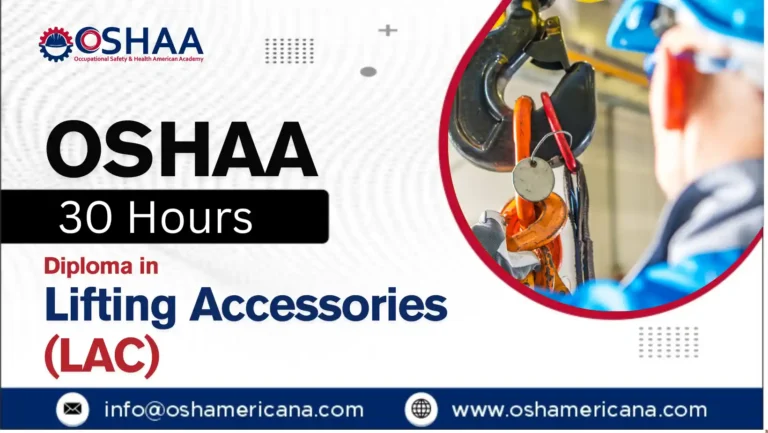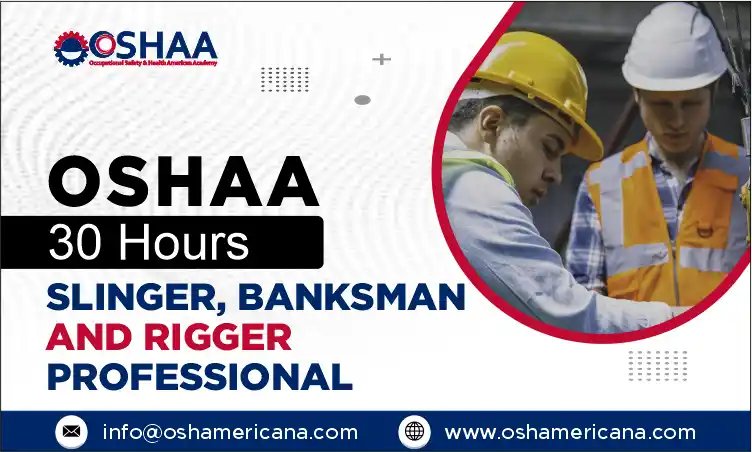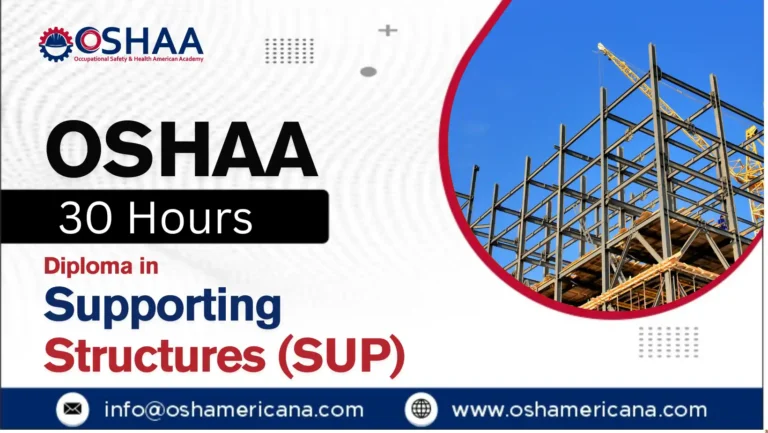Advance your career in lifting operations with the OSHAA Rigger Professional Course 30 Hours, mastering rigging techniques, safety, and regulatory compliance.
The OSHAA Rigger Professional Course 30 Hours is a specialized and comprehensive training program designed to provide professionals with the advanced knowledge and practical skills essential for safe and efficient rigging operations. In industries such as construction, manufacturing, shipping, and logistics, the role of a rigger is critical for ensuring the secure handling, lifting, and movement of heavy loads. This course equips participants to manage complex lifting operations while prioritizing workplace safety, operational efficiency, and full compliance with industry regulations.
Over the span of 30 hours, the course offers in-depth instruction on all facets of rigging, including load assessment, proper use of rigging equipment, securing loads, and coordinating with crane operators. Participants gain practical expertise in identifying hazards, implementing risk mitigation strategies, and applying safety protocols in real-world environments. The curriculum emphasizes the legal and regulatory standards governing rigging and lifting operations, ensuring that learners are fully prepared to maintain compliance with OSHA and other relevant safety guidelines.
The OSHAA Rigger Professional Course 30 Hours combines theoretical knowledge with hands-on exercises, allowing participants to develop the confidence and competency needed to handle lifting operations in high-risk environments. Through this program, learners acquire the ability to plan and execute rigging tasks efficiently, make informed decisions under pressure, and foster a culture of safety among team members. The practical training also enhances problem-solving skills, situational awareness, and leadership capabilities critical for managing rigging teams on-site.
Ideal for construction workers, industrial operators, logistics personnel, and safety professionals, the OSHAA Rigger Professional Course 30 Hours is a strategic investment in career development. Completing this course positions participants as skilled and certified rigging professionals, capable of improving operational reliability, reducing workplace accidents, and contributing to long-term safety and compliance excellence. With its comprehensive approach, the OSHAA Rigger Professional Course 30 Hours ensures that participants leave fully equipped to excel in the demanding field of rigging and lifting operations, supporting both individual career growth and organizational performance.
OSHAA Rigger Professional Course 30 Hours
To enroll in the OSHAA Rigger Professional Course 30 Hours, learners are expected to meet the following criteria:
- Age Requirement – Participants must be at least 18 years of age to enroll in the OSHAA Rigger Professional Course 30 Hours. This ensures that learners possess the maturity and physical capability to safely participate in practical rigging exercises and adhere to safety protocols.
- Educational Background – Learners are recommended to have completed a minimum of secondary education or high school. Higher education or technical qualifications in construction, industrial operations, or related fields is advantageous and can enhance understanding of complex rigging principles and safety regulations covered in the OSHAA Rigger Professional Course 30 Hours.
- Work Experience – Prior experience in construction, industrial operations, logistics, or rigging is recommended but not mandatory. Practical experience can help learners better relate to real-world scenarios and maximize the benefits of the OSHAA Rigger Professional Course 30 Hours, though the course is designed to equip both beginners and experienced professionals with the necessary skills.
- English Proficiency – Learners must be able to read, write, and communicate effectively in English to fully comprehend the course materials, follow safety instructions, and understand regulatory requirements. Proficiency in English ensures participants can successfully complete the OSHAA Rigger Professional Course 30 Hours and apply its knowledge to maintain compliance and safety in lifting operations.
This comprehensive approach ensures that all participants in the OSHAA Rigger Professional Course 30 Hours are adequately prepared to gain maximum benefit from the training, develop practical rigging expertise, and achieve professional growth in accordance with industry standards and safety regulations.
Study Units
Learning Outcomes
The Learning Outcomes section for the OSHAA Rigger Professional Course 30 Hours is designed to clearly define the skills, knowledge, and competencies learners will acquire. This course equips participants with advanced rigging expertise, compliance knowledge, and leadership abilities essential for ensuring safety and operational efficiency in lifting operations across construction, industrial, and heavy-duty work environments. By completing this course, learners gain the confidence and technical proficiency required to implement rigorous safety standards while optimizing workflow and maintaining regulatory compliance.
- Introduction to Rigging and Safety Protocols (4 Hours)
- Develop a comprehensive understanding of fundamental rigging principles and safety protocols essential for all lifting operations.
- Recognize common hazards associated with rigging and implement preventive measures to mitigate risks.
- Understand the responsibilities and roles of riggers in maintaining a safe and compliant work environment.
- Build foundational knowledge to effectively integrate safety standards into all rigging activities.
- Rigging Equipment and Tools (5 Hours)
- Identify, select, and inspect various rigging equipment and tools used in lifting operations.
- Understand load capacities, limitations, and proper handling techniques for slings, shackles, hoists, and other rigging tools.
- Apply best practices for equipment maintenance and safety checks to prevent equipment failure and accidents.
- Develop the ability to match the correct equipment to specific lifting tasks while ensuring regulatory compliance.
- Load Calculations and Weight Distribution (4 Hours)
- Gain proficiency in calculating load weights and assessing proper weight distribution for safe lifting operations.
- Understand the principles of center of gravity, load balancing, and mechanical advantage in rigging scenarios.
- Apply mathematical and practical methods to prevent overloading, equipment damage, and workplace accidents.
- Strengthen decision-making skills for safe and efficient planning of lifting operations.
- Basic and Advanced Rigging Techniques (5 Hours)
- Master fundamental rigging methods including knotting, hitching, and securing loads.
- Apply advanced techniques for complex lifts involving multiple points, unusual loads, or challenging environments.
- Integrate safety checks and procedural protocols to minimize risk during both simple and complex lifts.
- Build competence in adapting rigging strategies to dynamic operational requirements.
- Risk Assessment and Hazard Identification (4 Hours)
- Develop the ability to systematically identify potential hazards in lifting and rigging operations.
- Conduct risk assessments to evaluate the probability and severity of accidents.
- Implement corrective measures and safe work practices to mitigate identified risks.
- Enhance situational awareness and proactive safety management skills.
- Legal Regulations and Compliance in Rigging (5 Hours)
- Acquire detailed knowledge of OSHA standards and other relevant regulatory requirements applicable to rigging.
- Understand legal responsibilities of riggers and management in ensuring workplace safety.
- Apply compliance strategies to daily operations, documentation, and reporting procedures.
- Strengthen the ability to maintain regulatory adherence while optimizing operational efficiency.
- Communication and Coordination in Rigging Operations (3 Hours)
- Develop effective communication skills to coordinate lifting operations with team members and crane operators.
- Learn standardized signaling techniques and verbal protocols for safe and accurate load handling.
- Enhance teamwork and situational coordination to prevent miscommunication-related incidents.
- Build leadership abilities to guide safe and efficient rigging activities across diverse work environments.
Completing the OSHAA Rigger Professional Course 30 Hours ensures participants are fully prepared to lead lifting operations with confidence, implement rigorous safety measures, maintain compliance with regulatory standards, and cultivate a strong safety culture. Graduates of this course will possess advanced technical skills, operational expertise, and the leadership competencies necessary to enhance workplace safety, reduce accidents, and drive efficiency across all rigging and lifting operations.
The OSHAA Rigger Professional Course 30 Hours offers a comprehensive suite of benefits designed to elevate professional competence, enhance workplace safety, and ensure regulatory compliance in rigging and lifting operations. This course is highly relevant to industry professionals, organizations, and stakeholders who are committed to operational excellence and risk reduction. By completing this course, participants gain practical skills, advanced knowledge, and certifications that improve safety performance, operational efficiency, and career prospects across construction, industrial, and heavy-duty environments. The course equips learners with the tools to apply OSHA standards effectively while fostering a culture of safety, accountability, and continuous improvement.
- Advanced Knowledge in Rigging Operations
- Participants acquire in-depth understanding of rigging principles, equipment, and techniques, allowing them to safely and efficiently manage complex lifting operations.
- Knowledge gained ensures the ability to plan, execute, and supervise lifting tasks while adhering to best practices and industry standards.
- Enhances professional credibility and technical expertise, positioning participants as skilled rigging specialists.
- Enhanced Workplace Safety and Risk Reduction
- Learners develop the skills to identify hazards, conduct risk assessments, and implement preventive measures in lifting operations.
- Reduces the likelihood of accidents, injuries, and property damage, creating a safer work environment for all personnel.
- Supports organizations in achieving compliance with OSHA and international safety regulations.
- Regulatory Compliance and Legal Protection
- The course emphasizes adherence to OSHA standards and other regulatory frameworks relevant to rigging operations.
- Participants learn to document and implement compliance strategies, minimizing legal liabilities for individuals and organizations.
- Ensures workplaces meet industry requirements, protecting organizations from fines and operational disruptions.
- Practical Skill Development and Hands-On Competence
- The course integrates practical exercises and real-world scenarios to build confidence in handling lifting equipment and rigging tasks.
- Participants acquire hands-on experience in signaling, load slinging, and crane coordination, enhancing operational proficiency.
- Enables immediate application of skills in workplace settings, improving both safety and productivity.
- Operational Efficiency and Cost Savings
- By mastering efficient rigging techniques, participants contribute to optimized workflow, reduced downtime, and fewer operational delays.
- Proper load handling and rigging practices prevent equipment damage, lowering maintenance and replacement costs.
- Improves resource utilization, contributing to overall organizational efficiency and profitability.
- Leadership and Team Coordination
- Learners develop leadership skills essential for supervising lifting operations and guiding team members safely.
- Effective communication and coordination training ensure smooth execution of complex lifts, preventing miscommunication-related incidents.
- Positions participants as reliable leaders capable of managing safety-critical tasks in high-pressure environments.
- Career Advancement and Professional Recognition
- Completion of the OSHAA Rigger Professional Course 30 Hours enhances career prospects by certifying technical expertise in rigging.
- Professionals gain recognition as competent specialists, opening opportunities in construction, industrial, and logistics sectors.
- Supports long-term career growth and specialization in occupational safety and rigging management.
- Emergency Preparedness and Incident Management
- Participants learn protocols for responding to emergencies, equipment failures, or lifting incidents.
- Improves readiness to manage unforeseen events safely, minimizing risk to personnel and assets.
- Contributes to resilient and prepared workplaces capable of handling operational disruptions.
- Continuous Improvement and Innovation
- The course encourages the adoption of modern rigging techniques and innovative safety practices.
- Participants develop the ability to evaluate, refine, and implement improved lifting procedures over time.
- Fosters a culture of continuous learning and operational excellence within organizations.
- Worker Well-Being and Productivity Enhancement
- Emphasis on safe lifting practices reduces the physical strain on personnel and prevents musculoskeletal injuries.
- Promotes health, well-being, and productivity among rigging teams, contributing to overall workforce morale.
- Enhances organizational reputation by prioritizing employee safety and operational integrity.
- Comprehensive Understanding of Rigging Equipment
- Learners gain detailed knowledge of rigging tools, equipment capacities, and maintenance requirements.
- Ensures the correct selection and use of equipment, preventing accidents and enhancing safety compliance.
- Strengthens organizational adherence to technical standards and operational reliability.
- Strategic Decision-Making Skills
- The course develops analytical skills for planning lifts, managing loads, and mitigating potential risks.
- Enables informed decisions in real-time lifting operations, ensuring safe and efficient task completion.
- Supports management in strategic planning for complex industrial and construction projects.
- Enhanced Safety Culture and Organizational Compliance
- Participants become advocates for safety culture, promoting awareness and accountability across teams.
- Facilitates consistent adherence to internal policies and external regulatory requirements.
- Contributes to the long-term sustainability of workplace safety programs and organizational compliance initiatives.
- Integration of Theoretical Knowledge with Practical Application
- Combines OSHA standards, regulatory knowledge, and hands-on experience to create well-rounded professionals.
- Bridges the gap between classroom learning and workplace execution, enhancing confidence and effectiveness.
- Prepares participants to handle diverse rigging challenges with competence and precision.
- Global Industry Relevance and Standardization
- Skills and knowledge gained are applicable across multiple sectors worldwide, including construction, manufacturing, and logistics.
- Ensures participants are aligned with international safety standards, expanding career mobility and professional versatility.
- Promotes universally recognized best practices, contributing to global workplace safety improvements.
The OSHAA Rigger Professional Course 30 Hours delivers an unparalleled combination of technical expertise, operational skills, and safety leadership. Participants leave the course equipped to lead rigging operations confidently, maintain regulatory compliance, and foster a culture of safety, efficiency, and continuous improvement, making it an essential investment for professionals and organizations committed to operational excellence.
The OSHAA Rigger Professional Course 30 Hours is designed for professionals seeking to enhance their skills in rigging, lifting operations, and workplace safety. This course is highly relevant to industry professionals, organizations, and stakeholders who are responsible for operational efficiency, regulatory compliance, and employee safety. By providing comprehensive training in rigging techniques, load management, and OSHA standards, this course equips participants with advanced knowledge and practical skills that are essential for ensuring safe and efficient lifting operations across construction, manufacturing, and industrial environments. It prepares learners to lead safety initiatives, promote regulatory compliance, and contribute to a culture of operational excellence.
- Safety Managers and HSE Officers
- Oversee workplace safety programs and ensure compliance with OSHA standards and industry regulations.
- Gain in-depth expertise in rigging operations, load management, and hazard mitigation.
- Develop the ability to implement structured safety protocols that reduce incidents and enhance operational efficiency.
- Strengthen leadership skills for supervising lifting operations and coordinating safety measures across teams.
- Construction Supervisors and Site Managers
- Responsible for managing on-site operations, including lifting and rigging activities.
- Acquire the knowledge to plan, execute, and monitor lifting operations safely and efficiently.
- Improve decision-making capabilities in high-risk environments, ensuring both personnel and equipment safety.
- Support organizational compliance with OSHA regulations while maintaining project timelines and productivity.
- Industrial and Manufacturing Professionals
- Engage in lifting, load handling, and material movement within industrial settings.
- Gain practical skills in rigging, signaling, and risk assessment to minimize workplace hazards.
- Enhance technical proficiency to execute complex lifting tasks with confidence and accuracy.
- Contribute to operational efficiency and safety compliance, reducing downtime and preventing accidents.
- Rigging and Lifting Operators
- Directly involved in handling loads, crane operations, and rigging tasks.
- Learn advanced rigging techniques, proper signaling, and load management practices.
- Develop the ability to identify and mitigate potential hazards during lifting operations.
- Support a safer workplace by adhering to OSHA standards and implementing best practices in rigging.
- Safety Consultants and Trainers
- Advise organizations on safety protocols, compliance strategies, and risk management.
- Acquire comprehensive knowledge of rigging and lifting operations to enhance training programs.
- Equip teams with practical skills and regulatory insights, fostering a culture of safety and compliance.
- Improve credibility and professional expertise, positioning themselves as trusted advisors in occupational safety.
- Logistics and Transport Professionals
- Involved in the loading, securing, and movement of materials and equipment.
- Learn proper rigging and load handling procedures to prevent accidents and damage.
- Ensure compliance with OSHA standards and maintain operational efficiency during transport operations.
- Enhance the ability to coordinate lifting activities and mitigate risks in industrial and logistics environments.
The OSHAA Rigger Professional Course 30 Hours equips participants across all roles with advanced technical knowledge, practical skills, and certifications necessary to excel in rigging and lifting operations. Graduates are prepared to enhance workplace safety, ensure regulatory compliance, improve operational efficiency, and foster a culture of safety and professionalism within their organizations, making it a strategic investment for career development and organizational success.

